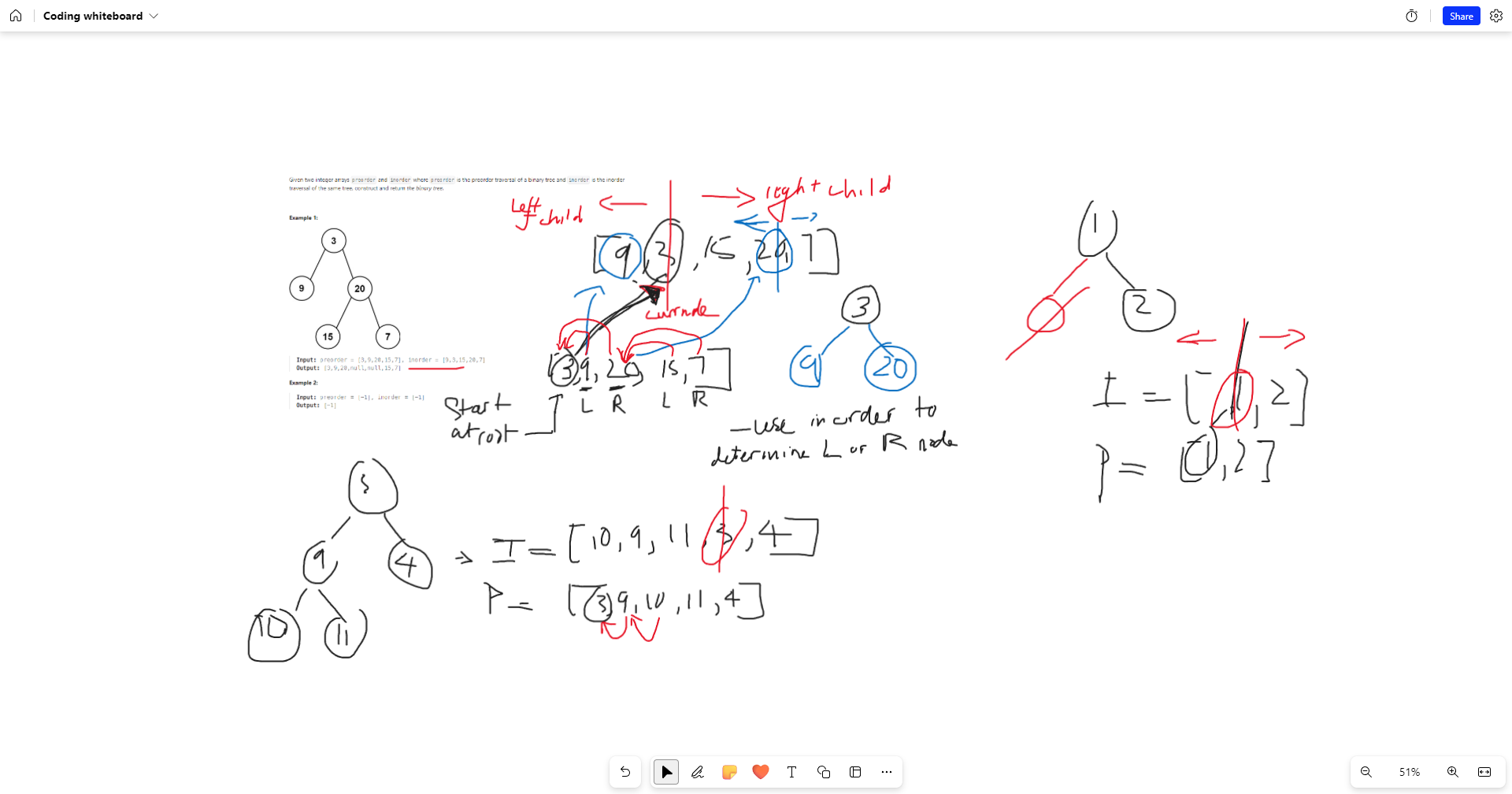Problem of The Day: Construct Binary Tree from Preorder and Inorder Traversal
Problem Statement
Given two integer arrays preorder and inorder where preorder is the preorder traversal of a binary tree and inorder is the inorder traversal of the same tree, construct and return the binary tree.
Example 1:
3
/ \
9 20
/ \
15 3
Input: preorder = [3,9,20,15,7], inorder = [9,3,15,20,7]
Output: [3,9,20,null,null,15,7]
Example 2:
Input: preorder = [-1], inorder = [-1]
Output: [-1]
My Explanation and Approach
In approaching this problem, I adopted the divide and conquer concept to devise a solution. The fundamental idea revolves around breaking down the problem into sub-problems and utilizing recursion to construct the solution iteratively. Let’s consider the given example as our main problem:
Input: preorder = [3,9,20,15,7], inorder = [9,3,15,20,7]
Understanding the patterns of preorder (node -> left -> right) and inorder (left -> node -> right), I exploited this information. The process involves using the inorder array to determine the placement of nodes on the left or right side of our tree at a particular node. Simultaneously, the preorder array helps build the tree or subtrees one node at a time.
Starting with the root node 3, identified as the first node in the preorder array, I found its index in the inorder array. Nodes to the left of this index become the left subtree, and those on the right become the right subtree.
Subsequently, recursion is employed to solve sub-problems: how to construct the left and right subtrees using the modified preorder and inorder arrays, excluding the root node 3.
Preorder:
node -> left -> right
Inorder:
left -> node -> right
For instance:
Input: preorder = [3,9,20,15,7], inorder = [9,3,15,20,7]
^
start here - this is our root node
left tree | right tree
v | v
inorder = [9,3,15,20,7]
|
Then, our sub-problems become the following.
build tree for left subtree
Input: preorder = [9,20,15,7], inorder = [9]
build tree for right subtree
Input: preorder = [9,20,15,7], inorder = [3,15,20,7]
Repeat the steps above to build left subtree.
Input: preorder = [9,20,15,7], inorder = [9]
^
root node left tree
left tree | right tree
inorder = [9]
In this case, if we call helper function for left or right tree, the inorder input of recursion call will be empty
Repeat the steps above to build right subtree.
Input: preorder = [9,20,15,7], inorder = [3,15,20,7]
^
root node left tree
In this case, since 9 is not present in the inorder -> this tells us that the parent node shall have the left node which is 9 and right node is Null
I repeated these steps for each subtree, progressively building the binary tree. The recursion stops when the inorder input becomes empty or the helper’s index surpasses the length of the preorder array.
The resulting algorithm efficiently leverages the divide and conquer technique, recursively constructing the binary tree from the given preorder and inorder traversals.
# Definition for a binary tree node.
# class TreeNode:
# def __init__(self, val=0, left=None, right=None):
# self.val = val
# self.left = left
# self.right = right
class Solution:
def buildTree(self, preorder: List[int], inorder: List[int]) -> Optional[TreeNode]:
def helper(preorder, inorder):
if helper.index >= len(preorder) or not inorder:
return
val = preorder[helper.index]
root = TreeNode(val)
val_idx = inorder.index(val)
helper.index += 1
root.left = helper(preorder, inorder[:val_idx])
root.right = helper(preorder, inorder[val_idx + 1:])
return root
helper.index = 0
return helper(preorder, inorder)
Leet Code Solution
class Solution:
def buildTree(self, preorder: List[int], inorder: List[int]) -> TreeNode:
def array_to_tree(left, right):
nonlocal preorder_index
# if there are no elements to construct the tree
if left > right: return None
# select the preorder_index element as the root and increment it
root_value = preorder[preorder_index]
root = TreeNode(root_value)
preorder_index += 1
# build left and right subtree
# excluding inorder_index_map[root_value] element because it's the root
root.left = array_to_tree(left, inorder_index_map[root_value] - 1)
root.right = array_to_tree(inorder_index_map[root_value] + 1, right)
return root
preorder_index = 0
# build a hashmap to store value -> its index relations
inorder_index_map = {}
for index, value in enumerate(inorder):
inorder_index_map[value] = index
return array_to_tree(0, len(preorder) - 1)
